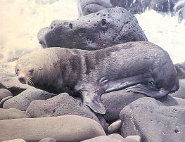 The Guadalupe fur seal (Arctocephalus townsendi) spends much of its time in the water, coming to land to breed. Named for their main breeding ground, Isla Guadalupe, the seals have been spotted on islands off the coast of Baja California, Mexico, as well as islands off the coast of southern California in the US. The elusive Guadalupe fur seal has not been studied much because of the rarity of sightings.
The Guadalupe fur seal (Arctocephalus townsendi) spends much of its time in the water, coming to land to breed. Named for their main breeding ground, Isla Guadalupe, the seals have been spotted on islands off the coast of Baja California, Mexico, as well as islands off the coast of southern California in the US. The elusive Guadalupe fur seal has not been studied much because of the rarity of sightings.In the 19th century, Guadalupe fur seals were nearly driven into extinction along the Baja California coast by commercial sealers. Colonies off the southern California coast vanished by 1892, when the entire species consisted of only seven known seals. For a time, Guadalupe fur seals were believed to be extinct. Until 1954, only five seals had been spotted in addition to two Guadalupe fur seals that were housed in the San Diego Zoo. In 1954, a colony of 14 Guadalupe fur seals was spotted, and the species has been able to make a comeback. Despite the re-population of the species, the Guadalupe fur seal remains the rarest of the fur seals, and is still listed on the US endangered species list. In the 1970s, Isla Guadalupe was officially declared a refuge for the seals by the Mexican government, and the island population has grown to over 7,000.
Guadalupe fur seals grow to an adult size of 2.2m (7.2 feet) and 188kg (414.
Although the species does not migrate, the seals do have separate areas used for day-to-day living, and their May-July breeding season, when they prefer rocky, secluded areas. After giving birth, female Guadalupe fur seals venture out to sea for a 2-6 day feeding session.
The Guadalupe fur seal, lower californian fur seal is listed as Vulnerable (VU), considered to be facing a high risk of extinction in the wild, on the IUCN Red List of Threatened Species
Namings for the Guadalupe fur seal
A young / baby of a Guadalupe fur seal is called a 'pup'. The females are called 'cow' and males 'bull'. A Guadalupe fur seal group is called a 'pod, colony, crash, flock, harem, bob, herd, rookery, team or hurd'.
Custom Search